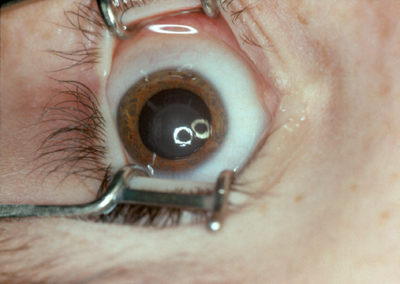A cataract is a clouding of the eye’s normally clear lens. The lens of the eye plays an important role in focusing images on the retina, the light-sensitive nerve cells lining the back of the eye. If the lens loses its clarity, light rays do not focus clearly, and your vision becomes blurry. Just as it is hard to see through a dirty window, it is hard to see through a cataract. Although most cataracts occur in older adults, they can appear in children, in one or both eyes, often at birth. They look like a white or gray spot in the pupil.

Cataracts in children can be inherited, or they can develop because of an infection or a disease acquired before birth. They can also be caused by an injury. In most cases, no specific cause is found.
Children may lose vision permanently because of amblyopia (“lazy eye”) if a severe cataract is not removed quickly. The better eye may also need to be patched. Mild cataracts may not need treatment.
The focusing power of the original lens, removed during cataract surgery, must be replaced to restore vision. Intraocular lenses (IOLs), permanent synthetic lenses placed inside the eye, can be implanted in older children much as they are in adults. In infants and small children, IOLs are controversial because a child’s eyes change and grow during the first few years of life, and the prescription needed for good vision changes as well. Many surgeons prefer contact lenses or even eyeglasses for younger children.
Regardless of the type of correction, children need follow-up exams to avoid possible complications, which can include glaucoma, scar tissue formation in the pupil, and amblyopia. Often, children will need eye muscle surgery if the eye “turns” or “crosses.”
Despite these problems, cataracts are the single most treatable cause of childhood blindness. After surgery, most children can see the blackboard in school (20/60–20/100). While some do not do as well, with appropriate correction, many children see almost normally after cataract surgery.
(c) 2007 The American Academy of Ophthalmology
